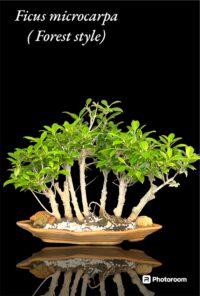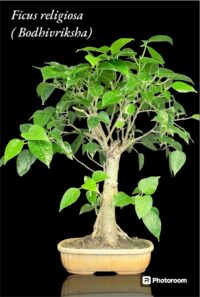how bonsai trees are Grown
How Bonsai Trees Are Grown: The Art of Miniature Gardening
Are you fascinated by the art of bonsai? Do you wonder how these miniature trees are created and maintained? Bonsai is a Japanese art form that involves cultivating small trees that mimic the shape and scale of mature trees in nature. The process of creating bonsai trees requires patience, skill, and a deep understanding of horticulture. In this article, we will explore the process of how bonsai trees are made, step by step.

For deeper knowledge Growing Bonsai From 1 Seedling, A Step-by-Step Guide
Introduction – How Bonsai Trees Are Grown
Bonsai trees are a unique and beautiful way to bring the beauty of nature indoors. They are often used as decorative pieces, adding a touch of tranquillity to any space.
Bonsai trees are not just ordinary plants that can be grown easily; they are rather miniature trees that require careful and precise care. The art of creating a bonsai tree is a combination of horticultural knowledge, patience, and artistic vision. Here we will understand how quickly we can make a bonsai out of a simple garden plant.
How Bonsai Trees Are Made
The process of making a bonsai tree starts with selecting a suitable tree species.
Selection of desired Species:-
If you want to understand, how bonsai trees are grown, you have to know a particular tree species, many tree species are suitable for bonsai, including Ficus, Jade, Banyan, and many others. Once the species is selected, a bonsai artist will look for a young tree with a straight trunk and well-positioned branches.
For more Indian Tree species suitable for Bonsai making, Please go through Bonsai Tree Species: Indoor Bonsai India& Rare Bonsai Tree Species. In our earlier articles, we have covered individual tree species in-depth.
The next step is to prune the tree, which involves trimming the branches and foliage to create a smaller version of the tree.
After pruning, the roots are trimmed to fit into a small container. The roots of a bonsai tree are trimmed regularly to keep the tree small and compact. Once the tree is potted, it is trained to grow in a specific direction. This is done by wiring the branches and trunk into the desired shape. The wiring process requires a lot of skill and precision to avoid damaging the tree.
The final step to know How Bonsai Trees Are Grown is the ongoing care and maintenance of the tree. This involves regular watering, fertilization, and pruning to keep the tree healthy and in shape. The care and maintenance of a bonsai tree can be challenging, but it is also a rewarding experience.
Selecting the Right Tree for Bonsai
When it comes to bonsai trees, not all species are created equal. Some tree species are better suited for bonsai than others. The ideal tree species for bonsai should have small leaves, a naturally gnarled trunk, and a relatively slow growth rate. Some of the most popular tree species for bonsai include:
Banyan Tree, Pilkhan, Lipstick Ficus, Gular, Chinese elm, Carmona, Jade, Divi Divi, Karonda, Kalp Vriksha, Jungle Jalebi etc.
Check Out these links for a detailed study on individual tree species Rare Bonsai Tree Species. Neem Bonsai Tree Species, Bargad Bonsai Tree Species-The Authentic Bonsai, Carmona Bonsai Dynamic Tree Species India.
Pruning and Shaping Bonsai Trees
Pruning and shaping are the two most important aspects of creating a bonsai tree.
- Pruning involves removing unnecessary branches and leaves to create a smaller version of the tree.
- Shaping involves wiring the branches and trunk into the desired shape.
Wiring
- The wire is wrapped around the branch or trunk and bent into the desired shape.
- The wire is left on the tree for a few months to allow the tree to grow into the desired shape. Once the tree has grown into the desired shape, the wire is removed.
- Both of these techniques require a lot of skill and patience. The same has been explained in detail here.
Pruning
- Pruning should be done in the early spring when the tree is still dormant. (February) This is when the tree has the most energy reserves and can recover quickly from pruning.
- Pruning aims to remove any branches or foliage that are unnecessary or out of proportion with the rest of the tree, will see and discuss this later below.
Bonsai Soil and Pot Selection
- Bonsai soil is a mix of organic and inorganic materials that allows for proper drainage and aeration while retaining moisture.
- The ideal bonsai soil should be able to hold moisture, but not become waterlogged.
- The Pot for a bonsai tree should be small and shallow, with drainage holes at the bottom.
- The Pot should be proportional to the size of the tree, and it should be made of a material that allows for proper drainage and aeration.
- Ceramic or clay pots are often used for bonsai trees because they allow for proper drainage and aeration while retaining.
Watering and Fertilizing Bonsai Trees
Proper watering and fertilization are crucial to the health of a bonsai tree. Bonsai trees require regular watering, but they should not be overwatered. The frequency of watering depends on the climate and tree species. As a general rule, bonsai trees should be watered when the soil feels dry to the touch.
Fertilizing is also important for the health of a bonsai tree. Bonsai trees should be fertilized regularly with a balanced fertilizer that contains nitrogen, phosphorus, and potassium. It should be applied during the growing season when the tree is actively growing, we suggest using standard Vermicompost or Farm Yard Manure (FYM).
Common Mistakes in Bonsai Care
To master the art of “How bonsai trees are grown”, a few things must to kept in mind. While creating and maintaining a bonsai tree can be a rewarding experience, it can also be challenging. There are several common mistakes that people make when caring for bonsai trees. Here are a few of the most common mistakes:
- Overwatering: Overwatering is the most common mistake that people make when caring for bonsai trees. Overwatering can cause the roots to rot.
- Underwatering: Underwatering can also be a problem for bonsai trees. Bonsai trees require regular watering, and if they are not watered enough, they can become dehydrated and die.
- Improper pruning: Pruning should be done carefully and with a sharp tool to avoid damaging the tree.
- Improper wiring: Wiring should be done carefully to avoid damaging the branches or trunk of the tree. The wire should also be removed promptly once the tree has grown into the desired shape.
- Using the wrong soil: Using the wrong soil can be detrimental to the health of the tree. Bonsai trees require soil that allows for proper drainage and aeration while retaining moisture.
Step-by-Step Guide to Make a Pilkhan Bonsai.
Watch this video to see, How Bonsai Trees are Grown, the video was specially shot for the convenience of our readers and followers, to understand easily the whole process. If there are any doubts or suggestions, please comment below.
How Bonsai Trees Are Grown, Conclusion
Bonsai trees are beautiful and unique plants that require patience, skill, and dedication to create and maintain. From selecting the right tree species and container to proper watering and fertilization, there are many factors to consider when caring for a bonsai tree. By avoiding common mistakes and following best practices, anyone can create a beautiful and healthy bonsai tree.
Remember, the key to success with bonsai is to be patient and attentive to the needs of the tree. With proper care and attention, a bonsai tree can be a rewarding and fulfilling addition to any home or garden.
FAQ
What is the difference between bonsai and regular trees?
Bonsai trees are miniature versions of trees that are carefully cultivated to mimic the shape and scale of mature trees in nature. They are not dwarf trees or chemically altered.
How long does it take to create a bonsai tree?
The process of creating a bonsai tree can take several years, depending on the size and type of tree.
How Bonsai Trees Are Grown in Indoors?
Can you turn any tree into a bonsai?
No, not all tree species are suitable for Bonsais. While many tree species can be used for bonsai, some species are better suited for bonsai than others.
How often should I water my bonsai tree?
The frequency of watering depends on the climate and tree species. As a general rule, bonsai trees should be watered when the soil feels dry to the touch.
Do bonsai trees need sunlight?
Yes, bonsai trees require sunlight to grow and thrive. However, they should not be exposed to direct sunlight for extended periods, as this can cause the leaves to burn and dry out of soil quickly.
Bonsai Online
Grab the oppertunity to bring a bonsai at home.
Our Motto
What you see is what you get
Delivery
Personalised delivery at door step
Mission
Creating green spaces




